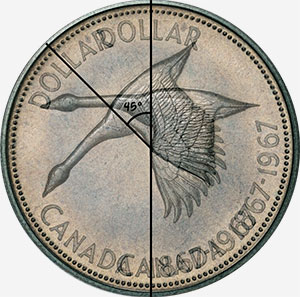Rotated die - Errors and varieties
Even if it isn't possible to know which of the two dies is responsible for a Rotated Die error, it can occur for two major reasons:
Stable Rotation
Occurs when one of the two dies has been misaligned during installation. Stable rotation produces multiple coins with a similar degree of rotation.
- 25 cents 1992 - Saskatchewan ↑↓
- 25 cents 2000 - Harmony ↑←
- 1 dollar 1967 - Coin alignement
- 1 dollar 1967 - 45% die rotation
Dynamic Rotation
Occurs when the hammer die has become loose while striking and it has rotated on its axis. For example, several degrees of rotation can be found on 1940 Canadian circulation coins, all denominations included.
How to calculate the rotation degree
To calculate the rotation degree, it is necessary to measure rotated side in relation to the other side of the coin.
List of hours, degrees and percentages
Rotated Die values
The value is based on the degree, date of the coin, rotation type, grade and denomination. Most Rotated Die with a rotation degree below 15% aren't valued above the regular version of the same coin. Here are some prices realized at auctions:
- $3,220 CAD - 5 cents 1965 PCGS AU-50 - 180 degrees
- $190 CAD - 5 cents 1940 ICCS MS-63 - 40 degrees
- $150 CAD - 25 cents 2000 Pride - 90 degrees
- $105 CAD - 1 dollar 1967 ANACS PL-66 - 20 degrees
- $90 CAD - 25 cents 1992 New Brunswick CCCS MS-60 - 180 degrees





